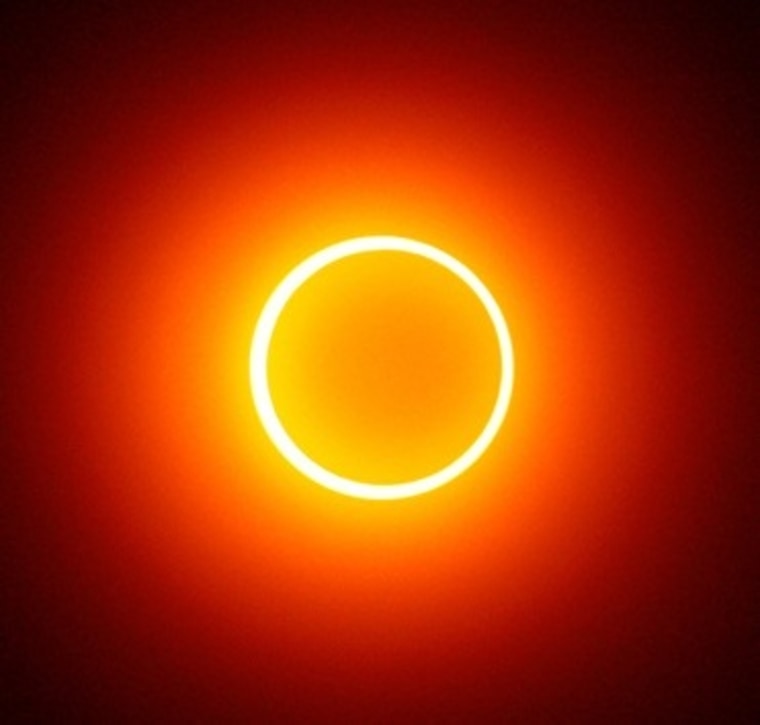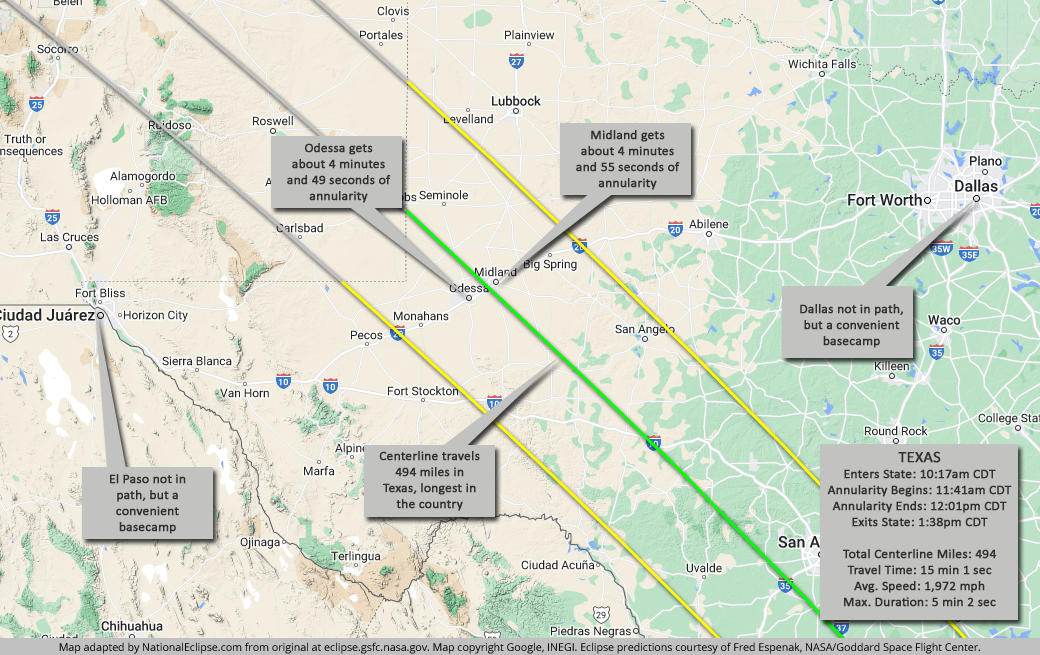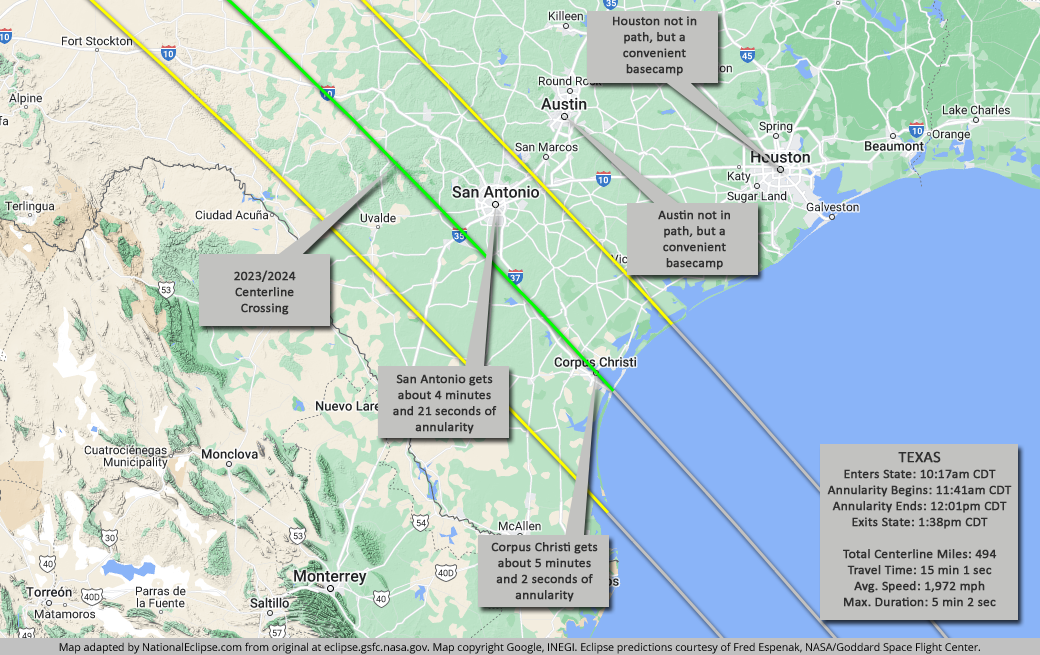Annular Solar Eclipse (October 2023)
Overview | Annular Eclipse in Texas | October Weather in Texas | Eye Safety | Solar Filters for Optics | Information Resources | Photography Articles and Videos
NOTE: The annular solar eclipse is a DIY event for members of the Plano Photography Club. We invite you to take advantage of the resources on this page and elsewhere on the internet to prepare for and experience this event in whatever manner and in whatever location that you choose.

NBC News/Reuters
Overview
On October 14, 2023, an annular, or "ring of fire," solar eclipse will carve a narrow path of annularity from northwest to southeast across eight U.S. states. To experience the annular, or "ring of fire," phase of the eclipse, you must be located within this narrow path of annularity, with the "ring of fire" lasting the longest at the centerline.
The centerline of the eclipse enters Texas at approximately 10:17am CDT, with annularity beginning in that location at about 11:41am CDT.
Remember that since the Moon never entirely covers the Sun during an annular, or "ring of fire," solar eclipse, you must use special eclipse safety glasses or viewers at all times. Unlike during a total solar eclipse, during an annular eclipse there is never a time when it's safe to look with unprotected eyes.
To determine the precise start time, end time, and duration of annularity for your exact location on eclipse day, use the interactive Google eclipse maps developed by Xavier Jubier.
The Annular Solar Eclipse in Texas


Midland and Odessa straddle the east and west sides of the eclipse centerline, respectively. In downtown Odessa, annularity will last for about 4 minutes and 49 seconds. Not bad, but Midland is a tad closer to the centerline, with annularity lasting for about 4 minutes and 55 seconds downtown, just 7 seconds short of the maximum duration of annularity anywhere in the country.
Interstate 20 bisects the entire width of the path in Texas and links it with El Paso to the west and the Dallas/Forth Worth area to the east, both only a day trip away. From El Paso, annularity can be reached by taking Interstate 10 to I-20. From Dallas, I-20 will take you all the way to annularity. To the north, Lubbock is even closer. You can reach the path in less than an hour by driving south on U.S. Route 87.
Farther along, the eclipse crosses over the largest city it will encounter along its journey through the United States. San Antonio is located about halfway between the centerline and the eastern limit of the eclipse path, with annularity lasting for about 4 minutes and 21 seconds downtown. In fact, it's important to note that all of San Antonio is located inside the 2023 eclipse path, which unfortunately is not the case six months later when only a portion of the city is captured inside the path of the total solar eclipse that will sweep across the U.S. on April 8, 2024. The lucky citizens of San Antonio will have a chance to experience two solar eclipses in the span of only six months, but only this annular solar eclipse on October 14, 2023, will cross over the heart of the city. To the west of San Antonio, a large diamond-shaped area in the Texas Hill Country is where the 2023 annular solar eclipse path overlaps with that of the 2024 total solar eclipse. The exact point where the centerlines cross is near the tiny town of Vanderpool.
Interstate 10 enters the eclipse path from the west before crossing the centerline and turning south to meet up with San Antonio. Interstate 35 crosses the entire width of the eclipse path, coming in from the south, crossing the centerline and San Antonio, and heading off toward Austin. In fact, Austin is so close to the eastern edge of the eclipse path that it can make an extremely convenient basecamp for eclipse chasers who prefer the fun of Austin over the fun of San Antonio. On eclipse day, it's a quick drive south on I-35 to reach the path. Houston is also relatively close on the east side. Drive west on I-10 to reach the path in less than three hours. Interstate 37 runs south from San Antonio down to the coast, tracing a path almost directly over the centerline. All of these interstate highways will make getting around this part of Texas easy on eclipse day, especially if cloudy skies requires a quick move to a different location.
The last major port of call for the eclipse in the U.S. is Corpus Christi. Since entering the U.S. in the Pacific Northwest, the eclipse's duration of annularity—or how long the Sun will appear as a perfect "ring of fire" in the sky—will have been steadily increasing, with the shortest durations on the Oregon coast and the longest durations here on the Gulf coast. What's more, the centerline of the eclipse—where durations last the longest in any one area—slices directly through the center of Corpus Christi. The result is a duration of annularity for this Gulf Coast city that cracks the 5-minute mark in some parts of town, including about 5 minutes and 2 seconds in the downtown area. These long durations make Corpus Christi a great eclipse-watching destination if you want the longest experience possible in the U.S. Just make sure to check short-term weather forecasts for the possibility of cloudiness along the shore during the late-morning hours. Obviously, a long duration of annularity is meaningless if you can't see the eclipse. The centerline last touches U.S. soil as it crosses over the city's barrier islands before heading out into the Gulf of Mexico, crossing through Central America and South America, and concluding its long journey in the Atlantic Ocean off the coast of Brazil.
The centerline of the eclipse exits the state, and the U.S., at approximately 1:38pm CDT, with annularity coming to an end in that location at about 12:01pm CDT. From the New Mexico-Texas border to the Gulf of Mexico, the Moon's shadow travels approximately 494 miles along the centerline in about 15 minutes and 1 second at an average speed of 1,972 miles per hour.
Source: NationalEclipse.com
October Weather in Texas

The lunar shadow enters Texas over the Llano Estacado (also known as the Staked Plains), crosses a steadily descending topography onto the Edwards Plateau, and then drops over the Balcones Fault onto the Texas Coastal Plain (please see the topographical map at right). Across the Llano and the Edwards Plateau there is little in the topography to distinguish the Llano from the Plateau (though there is a considerable difference in the geology). Most important is their elevations, ranging from 1100 m in the northwest to around 600 m in the southeast, a level that impedes the influx of low-level moisture from the Gulf of Mexico into the region. As the track drops over the Balcones Fault, the track is exposed to the humidity of Gulf weather.
The graph of centerline cloudiness shows a steady increase in cloud cover, rising about 10 percent (from 0.33 to 0.44) in the trek to lower elevations across the plateaus. The centerline is not representative of the whole of the track, however, as the average October cloud cover graphic (below) shows that the cloud cover increases much more quickly over the south side of the path. Beyond Scheffield, the south limit “falls off” the edge of the Edwards Plateau, moving across the lower terrain of the Rio Grande Valley. The valley acts as a funnel, allowing Gulf moisture to move inland to Del Rio and beyond where it contributes to the higher cloudiness on the south side of the track. On the north side of the centerline, cloud frequencies are similar to those along the centreline, but there is more variability from place to place than was the case over the Llano Estacado.

About half-way across Texas, before Hondo, there is an abrupt 7 percent upward jump in cloud cover on the centerline graph. This jump marks the transition from the Edwards Plateau to the lowland that surround the Gulf of Mexico. The lowlands are embedded in higher humidities than on the plateaus, so there is a corresponding increase in cloudiness. In some places, average cloud amounts reach 60 percent just before the coast, though not on the centreline.
Most cloudiness in the higher terrain in Texas comes from passing cold fronts and the occasional low-pressure system that develops over the state. October is beginning the transition to winter and these systems are becoming more common as cold weather approaches.
The availability of moisture on the Gulf Plain and the lower parts of the Edwards Plateau has a significant impact on the prospects for eclipse day. The region has high frequency of overnight and morning fog that may persist as an opaque layer of stratus through the day or turn into a broken layer of cumulus clouds. Fog also forms on the Edwards Plateau, especially in the lower, eastern parts, but this fog burns off in the morning, though it may still be lingering at the time of the eclipse.
Immediately offshore, October cloudiness drops below 40 percent, indicating that a significant part of the cloud found onshore is convective, created by daytime heating of the land. Satellite observations show that in mildly convective days, a sea-breeze circulation set up that brings cool Gulf air inland where it inhibits convection. This leaves an area of clear skies along the coast for a few kilometers inland and gives the coast a much lower average cloudiness. Inland from Corpus Christi, average cloud is measured at 0.57 (57 percent) while offshore it is 20 percent lower. The Gulf coast of Texas has many inlets (such as Corpus Christi Bay) that spread the cooling effect inland, but the strongest impact will be on the coast itself. The cooling associated with the approach of the lunar shadow will also help to suppress small convective clouds.
There is a gamble in staying near the coast however – if the day is particularly unstable, then the collision of the incoming sea breeze with unstable air over land will build deep convective clouds that may grow and spread high-level cloud back over the beaches. This is usually an afternoon phenomenon, but cannot be discounted during the morning arrival of the eclipse. The development of convection will depend on the instability of the day, which is well forecast by conventional weather models (just ask a storm-chaser).
Source: Eclipsophile.com
Eye Safety For Partial and Annular Solar Eclipses
Partial or annular solar eclipses are different from total solar eclipses – there is no period of totality when the Moon completely blocks the Sun's bright face. Therefore, during partial or annular solar eclipses, it is never safe to look directly at the eclipse without proper eye protection.
When watching a partial or annular solar eclipse directly with your eyes, you must look through safe solar viewing glasses (“eclipse glasses”) or a safe handheld solar viewer at all times. Eclipse glasses are NOT regular sunglasses; regular sunglasses, no matter how dark, are not safe for viewing the Sun. Safe solar viewers are thousands of times darker and must comply with the ISO 12312-2 international standard.
Always inspect your eclipse glasses or handheld viewer before use; if torn, scratched, or otherwise damaged, discard the device. Always supervise children using solar viewers.
Do NOT look at the Sun through a camera lens, telescope, binoculars, or any other optical device while wearing eclipse glasses or using a handheld solar viewer — the concentrated solar rays will burn through the filter and cause serious eye injury.
Do NOT use eclipse glasses or handheld viewers with cameras, binoculars, or telescopes. Those require different types of solar filters. When viewing a partial or annular eclipse through cameras, binoculars, or telescopes equipped with proper solar filters, you do not need to wear eclipse glasses. (The solar filters do the same job as the eclipse glasses to protect your eyes.)
Seek expert advice from an astronomer before using a solar filter with a camera, telescope, binoculars, or any other optical device. Note that solar filters must be attached to the front of any telescope, binoculars, camera lens, or other optics.
Source: NASA
Solar Filters For Optics
With one notable exception, it is never safe to look directly at the Sun through a telescope, binoculars, or camera lens without a solar filter. That exception is during totality, when the dazzlingly bright solar surface is completely blocked by the Moon. But totality is fleeting. Most of the time during an eclipse you’ll be watching the partial phases, during which filters are always required.
Telescopes, binoculars, and cameras need solar filters for two reasons: to protect them from intense sunlight and to ensure that you don’t accidentally look at the Sun through an unfiltered instrument. In every case, the solar filter must be attached to the front of your telescope, binoculars, or camera lens. This ensures that the Sun’s light and heat are kept out of the optics.
Make sure the filter is attached securely so it won’t pop off if your instrument is bumped or the wind suddenly gusts — but not so securely that you can't remove it easily at the beginning of totality!
If your telescope has a small auxiliary finder scope or other aiming device, make sure that it is capped, removed, or safely filtered just like the main telescope.
Solar filters provided with inexpensive telescopes, usually designed to thread into an eyepiece at the back end of the telescope, are dangerous. If the filter is attached to the spot where you place your eye, sunlight concentrated by your optics will burn right though it. This is also why looking through unfiltered optics while wearing eclipse viewers is extremely dangerous and a recipe for serious eye injury. We'll say it again: a solar filter must be attached to the front of your telescope, binoculars, or camera lens.
You’ll generally encounter three types of solar filters: metal on glass (usually the most durable and expensive), aluminized polyester film (frequently referred to as aluminized Mylar), and black polymer (sometimes with a layer of aluminized polyester on one side). Some render the Sun white, while others impart a yellow, orange, or bluish tint. All are effective, so choose the type that best suits your preference and budget.
Source: American Astronomical Society
National Information Resources
Photography
Articles
Videos